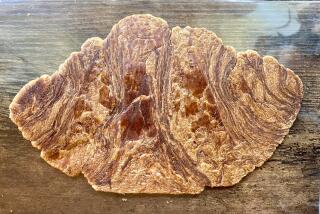Slow cookers have evolved over the decades
Fans affectionately refer to them with names like “recession-fighting machines” and “crackpots.” They call themselves “crockpotters” and wax poetic with a fervor normally reserved for religion, politics or love. “My entire family life revolves around the Crock-Pot,” says one. “I have not only embraced the Crock-Pot but am making out with it.”
Welcome to the slow-cooker movement. The new slow-cooker movement.
For many, it’s all about the convenience. A reluctant convert, Jane Park now rattles off a list of advantages: “I like that the house smells good all afternoon. I like that it eliminates the 5 o’clock panic of, ‘Oh, my gosh, what am I going to throw together for dinner?’ I like that I can make enough at a time to have leftovers. I like that the cheaper cuts of meat often work best.”
Others, like Goodwin Liu, love the potential. His expertise includes constitutional law and education policy, but in his spare time the associate dean and professor of law at UC Berkeley’s Boalt Hall likes to experiment with his slow cooker. A favorite discovery? Sweet potatoes. “I like to cook sweet potatoes over low heat -- they come out to a lovely mash.”
No, we’re not talking about your mother’s slow cooker here. Or her recipes. Forget the harvest gold floral patterns -- there are stainless-steel models out there that could be mistaken for mini-Hummers without the wheels (and they’re all electric).
And while stew may be fine, have you ever tried meltingly tender Cuban-marinated pork shoulder? How about a colorful lamb tagine, the fragrant aromas of cinnamon, honey and dried fruit perfuming your house all afternoon? Let’s not forget dessert -- perhaps some white-chocolate bread pudding? (You can cook up a quick whiskey caramel sauce while the pudding quietly bakes away on the counter.) It just takes a little know-how and patience.
Good -- and convenient -- things really can come to those who wait.
Crock-Pot ‘chic’
It all started with the Crock-Pot. Rival introduced the slow cooker to the market with the Crock-Pot brand in 1971. Almost overnight, the Crock-Pot enjoyed a popularity matched only by the fondue pot and defined a certain kind of culinary “chic” for the decade.
It “cooks all day while the cook’s away,” one 1976 advertisement declared. The Crock-Pot promised complete meals, cooked slowly over long periods of time, costing mere pennies to operate and requiring little, if any, supervision. Rival posted Crock-Pot sales of $2 million its first year on the market, and sales peaked at $93 million after just four years. Inevitably, it wasn’t long before competitors jumped on the bandwagon and flooded the market. By the end of the 1970s, sales of slow cookers, including the Crock-Pot, decreased dramatically.
Of course, the slow cooker also had its detractors -- and most complaints were about the food. Many thought everything tasted the same no matter what was in the pot. Others claimed the food dried out despite the closed cooking environment (the lid should prevent moisture from escaping). Some complained about the lack of flavor, others about the lack of visual appeal. Still others said the slow cooker just made mush.
Andrew Schloss, author of the new “Art of the Slow Cooker: 80 Exciting New Recipes,” says quality wasn’t really a consideration with many of the early recipes. “Earlier recipes were so much about convenience that a lot of the food wasn’t that good. Convenience started to trump quality.”
People liked the convenience of the slow cooker, they just didn’t necessarily like what had been cooked in them. Recipes began to evolve -- slowly -- as interest in the slow cooker grew once again over the last several years. And the cookers evolved too, with manufacturers offering different sizes and inserts (some that allow for conventional stove-top cooking) as well as offering programmable timers, “smart” settings and digital probes. Slow cookers improved cosmetically too.
Today, about 83% of American households own a slow cooker, according to the NPD Group, a leading marketing research firm. Of these households, almost half used a slow cooker within the past month.
Stephanie O’Dea blogged about using her slow cooker every day last year. Also known as the “Crockpot Lady,” her adventures (crockpot365.blogspot.com) were a hit, landing her a spot on the “Rachael Ray” show and spawning a cookbook, due out this fall. She believes the slow-cooker resurgence has a lot to do with the economy. “With the recession, people have realized they need to make real food at home.”
O’Dea, an avowed non-cook, liked the idea. “[Traditional cooking] is much more fast-paced and you run the risk of burning or doing something wrong. I wanted something simple, not too hard.” When she started slow-cooking, the meals were simple, mostly soups and stews.
But as the year progressed, she found herself taking on more and more complicated recipes, including falafel, tamales and even a delicate chocolate mousse. “There are so many things you can do with a Crock-Pot that you may not think of.”
Schloss agrees. The key, he says, is “using the machine to its advantage. It does some things well, and you should emphasize those things.”
A meat tenderizer
The obvious advantage to a slow cooker is the long, slow cooking process. Start with a recipe that complements this process, keeping in mind that tough, inexpensive cuts of meat are often perfect. The long, slow cooking process tenderizes the fat and connective tissue in the meat to a buttery texture.
For that Cuban pork, bone a picnic shoulder and remove the skin and outer fat. Cut the meat into large cubes -- don’t cook a single large piece of meat in a slow cooker because the length of time it takes to cook through could render it unsafe to eat. Then season them and place them on a bed of sliced onions. Add a little broth, start the cooker and let it go. Serve the pork with black beans and rice one night, then use the leftovers as part of another meal (salad, burritos, etc.).
To add another layer of flavor, take a few extra minutes to brown the meat, and add ingredients in stages to maximize their potential. Making lamb tagine, for example, you could just throw everything in the slow cooker and forget about it. But the dish will be better if you take a little time. Start by browning the meat. Season the lamb pieces and sauté them quickly -- this toasts the spices on the meat and will add richness and color to the dish (a lot of slow cookers now come with stove-top-safe inserts so you can brown and cook in the same pot, minimizing dirty dishes). Then, throw almost everything in the pot and let it go. About an hour or two before you’re ready, toss some dried dates on top of the mix. They’ll cook just long enough to soften but won’t turn to mush.
Perhaps the most important thing is just getting to know your slow cooker. Many models today heat more quickly than in the past (a recipe written 20 years ago calling for eight hours of cooking time might be done in six with one of today’s models), and because there’s no industry standard with respect to heat, the “high” and “low” temperature settings vary -- sometimes dramatically -- between makes and models.
O’Dea recommends starting with the recipes in the booklet that comes with the unit -- generally they’ve been well-tested for that particular machine. Master them, then play around.
And consider the possibilities. A slow cooker can make a perfect “second” oven, freeing the main oven for the main course or other dishes when company’s expected. It’s also perfect for summer cooking -- use the cooker instead of an oven to keep the kitchen cool.
Finally, consider the slow cooker for desserts -- the low, consistent heat is perfect for dense cakes, crumbles and even custards. Try it with bread pudding: Assemble and bake the pudding in the slow cooker, then serve as is or put it in a hot oven for 10 or 15 minutes -- the custard will soufflé and get a wonderful crunchy crust. Serve it with a warm caramel sauce for an easy dessert.
And maybe you’ve got an old fondue pot in the garage that you can use to keep the caramel sauce warm. Très chic.
More to Read
Sign up for The Wild
We’ll help you find the best places to hike, bike and run, as well as the perfect silent spots for meditation and yoga.
You may occasionally receive promotional content from the Los Angeles Times.











